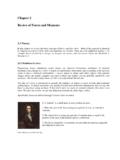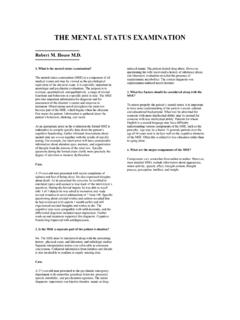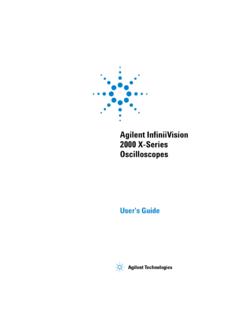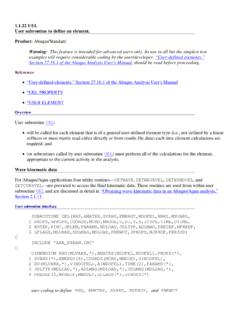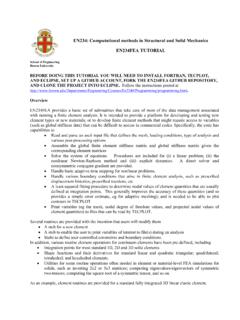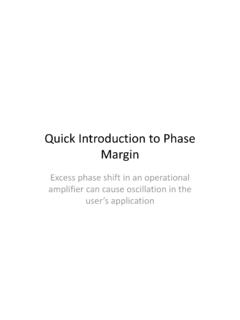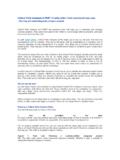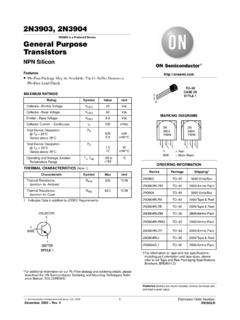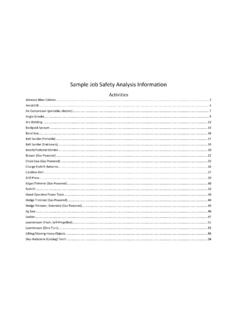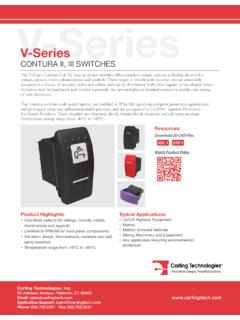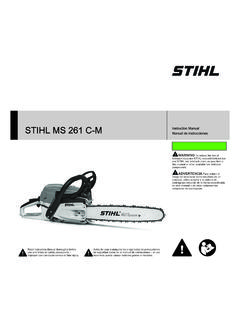Transcription of Chapter 5 Vibrations - Brown University
1 Chapter 5 Vibrations Overview of Vibrations Examples of practical vibration problems vibration is a continuous cyclic motion of a structure or a component. Generally, engineers try to avoid Vibrations , because Vibrations have a number of unpleasant effects: Cyclic motion implies cyclic forces. Cyclic forces are very damaging to materials. Even modest levels of vibration can cause extreme discomfort; Vibrations generally lead to a loss of precision in controlling machinery. Examples where vibration suppression is an issue include: Structural Vibrations . Most buildings are mounted on top of special rubber pads , which are intended to isolate the building from ground Vibrations .
2 The figure on the right shows vibration isolators being installed under the floor of a building during construction (from ) No Vibrations course is complete without a mention of the Tacoma Narrows suspension bridge. This bridge, constructed in the 1940s, was at the time the longest suspension bridge in the world. Because it was a new design, it suffered from an unforseen source of Vibrations . In high wind, the roadway would exhibit violent torsional Vibrations , as shown in the picture below. You can watch newsreel footage of the vibration and even the final collapse at To the credit of the designers, the bridge survived for an amazingly long time before it finally failed.
3 It is thought that the Vibrations were a form of self-excited vibration known as `flutter, or galloping A similar form of vibration is known to occur 2 in aircraft wings. Interestingly, modern cable stayed bridges that also suffer from a new vibration problem: the cables are very lightly damped and can vibrate badly in high winds (this is a resonance problem, not flutter). You can find a detailed article on the subject at Some bridge designs go as far as to incorporate active vibration suppression systems in their cables. Vehicle suspension systems are familiar to everyone, but continue to evolve as engineers work to improve vehicle handling and ride (the figure above is from A radical new approach to suspension design emerged in 2003 when a research group led by Malcolm Smith at Cambridge University invented a new mechanical suspension element they called an inerter.)
4 This device can be thought of as a sort of generalized spring, but instead of exerting a force proportional to the relative displacement of its two ends, the inerter exerts a force that is proportional to the relative acceleration of its two ends. An actual realization is shown in the figure. You can find a detailed presentation on the theory behind the device at ~ The device was adopted in secret by the McLaren Formula 1 racing team in 2005 (they called it the J damper , and a scandal erupted in Formula 1 racing when the Renault team managed to steal drawings for the device, but were unable to work out what it does.)
5 The patent for the device has now been licensed Penske and looks to become a standard element in formula 1 racing. It is only a matter of time before it appears on vehicles available to the rest of us. Precision Machinery: The picture on the right shows one example of a precision instrument. It is essential to isolate electron microscopes from Vibrations . A typical transmission electron microscope is designed to resolve features of materials down to atomic length scales. If the specimen vibrates by more than a few atomic spacings, it will be impossible to see! This is one reason that electron microscopes are always located in the basement the basement of a building vibrates much less than the upper floors.
6 Professor Kim at Brown recently invented and patented a new vibration isolation system to support his atomic force microscope on the 7th floor of the Barus-Holley building you can find the patent at United States Patent, Patent Number 7,543,791. Here is another precision instrument that is very sensitive to Vibrations . 3 The picture shows features of a typical hard disk drive. It is particularly important to prevent Vibrations in the disk stack assembly and in the disk head positioner, since any relative motion between these two components will make it impossible to read data.
7 The spinning disk stack assembly has some very interesting vibration characteristics (which fortunately for you, is beyond the scope of this course). Vibrations are not always undesirable, however. On occasion, they can be put to good use. Examples of beneficial applications of Vibrations include ultrasonic probes, both for medical application and for nondestructive testing. The picture shows a medical application of ultrasound: it is an image of someone s colon. This type of instrument can resolve features down to a fraction of a millimeter, and is infinitely preferable to exploratory surgery.
8 Ultrasound is also used to detect cracks in aircraft and structures. Musical instruments and loudspeakers are a second example of systems which put Vibrations to good use. Finally, most mechanical clocks use Vibrations to measure time. vibration Measurement When faced with a vibration problem, engineers generally start by making some measurements to try to isolate the cause of the problem. There are two common ways to measure Vibrations : 1. An accelerometer is a small electro- mechanical device that gives an electrical signal proportional to its acceleration. The picture shows a typical 3 axis MEMS accelerometer (you ll use one in a project in this course).
9 MEMS accelerometers should be selected very carefully you can buy cheap accelerometers for less than $50, but these are usually meant just as sensors, not for making precision measurements. For measurements you ll need to select one that is specially designed for the frequency range you are interested in sensing. The best accelerometers are expensive inertial grade versions (suitable for so-called inertial navigtation in which accelerations are integrated to determine position) which are often use Kalman filtering to fuse the accelerations with GPS measurements. 2. A displacement transducer is similar to an accelerometer, but gives an electrical signal proportional to its displacement.
10 Displacement transducers are generally preferable if you need to measure low frequency Vibrations ; accelerometers behave better at high frequencies. 4 Features of a Typical vibration Response The picture below shows a typical signal that you might record using an accelerometer or displacement transducer. Important features of the response are The signal is often (although not always) periodic: that is to say, it repeats itself at fixed intervals of time. Vibrations that do not repeat themselves in this way are said to be random. All the systems we consider in this course will exhibit periodic Vibrations .
